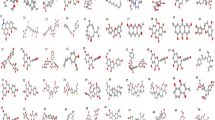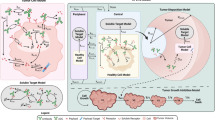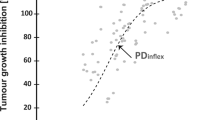Abstract
Purpose
Novel potent C-4 azolyl retinoic acid metabolism blocking agents (RAMBAs)—VN/14-1, VN/50-1, VN/66-1, VN/67-1, and VN/69-1, have been synthesized and investigated for their in vitro and in vivo effects against breast and prostate cancers. These RAMBAs, in addition to being potent inhibitors of all-trans-retinoic acid (ATRA) metabolism have potent anti-cancer properties and in vivo anti-tumor efficacies as characterized in breast and prostate cancer models. Here we determined the toxicity and pharmacokinetics (PK) of these various RAMBAs.
Methods
Preliminary acute toxicity studies of these RAMBAs were carried out using Swiss NIH mice. The toxicity profile of the RAMBAs was evaluated relative to ATRA. Three different doses (8.3, 33, and 100 μmol/kg/day) of ATRA and RAMBAs were administered on a daily basis subcutaneously for 14 days to the mice. Clinical signs of toxicity alopecia, scaly skin, and loss of body weight in the mice were observed during the study and the maximum tolerated dose was determined. PK of selected agents (VN/14-1, VN/50-1, and VN/66-1) was studied in Balb/C mice after a single dose subcutaneous administration. Plasma concentrations of the agents were quantitatively determined using a high-performance liquid chromatographic method with ultraviolet detection. Plasma concentration versus time profiles were fit to various PK structural models and relevant PK parameters were estimated.
Results
VN/66-1 and VN/69-1 were found to be the least toxic even at the highest doses when compared to the other RAMBAs and ATRA. VN/66-1 had the longest half-life, the slowest clearance, and the greatest exposure.
Conclusions
Based on PK characteristics and toxicity studies, VN/66-1 appeared to be the most favorable agent. However, both VN/14-1 and VN/66-1 are our leads based on the fact that VN/14-1 has been found to be highly effective in endocrine-sensitive and -resistant breast cancer cells and tumors with little toxicity. Our findings provide valuable information that will be used to select RAMBAs and establish therapeutic regimens that provide optimal efficacy with minimal toxicity.


Similar content being viewed by others
References
Adams J (1993) Structure-activity and dose-response relationships in the neural and behavioral teratogenesis of retinoids. Neurotoxicol Teratol 15:193–202
Altucci L, Gronemeyer H (2001) The promise of retinoids to fight against cancer. Nat Rev Cancer 1:181–193
Belosay A, Njar VCO, Brodie AMH (2006) Effects of novel retinoic acid metabolism blocking agent (VN/14-1) on letrozole insensitive breast cancer cells. Cancer Res 66:11489–11493
Bollag W (1975) Therapy of epithelial tumors with aromatic retinoic acid analog. Chemotherapy 21:236–247
Boyle JO (2001) Retinoids mechanisms and cyclins. Curr Oncol Rep 3:301–305
Cohen M (1993) Terinoin: a review of preclinical toxicological studies. Drug Dev Res 30:244–251
Dragnev KH, Rigas JR, Dmitrovsky E (2000) The retinoids and cancer prevention mechanisms. Oncologist 5:361–368
Fontana JA, Rishi AK (2002) Classical and novel retinoids: their targets in cancer therapy. Leukemia 16:463–472
Freemantle S, Spinella MJ, Dmitrovsky E (2003) Retinoids in cancer therapy and chemoprevention: promise meets resistance. Oncogene 22:7305–7315
Herr RJ (2002) 5-Substituted-1H-tetrazoles as carboxylic acid isosteres: medicinal chemistry and synthetic methods. Bioorg Med Chem 10:3379–3393
Huynh CK, Brodie AM, Njar VCO (2006) Inhibitory effects of retinoic acid metabolism blocking agents (RAMBAs) on the growth of human prostate cancer cells and LNCaP prostate tumour xenografts in SCID mice. Br J Cancer 94:513–523
Lindamood III C, Giles HD, Hill DL (1987) Preliminary toxicology profile of arotinoids SMR-2 and SMR-6 in male B6D2F1 mice. Fundam Appl Toxicol 8:517–530
Lindamood III C, Cope FO, Dillehay DL, Everson MP, Giles HD, Lamon EW, McCarthy DJ, Sartin JL, Hill DL (1990) Pharmacological and toxicological properties of carotinoids SMR-2 and SMR-6 in mice. Fundam Appl Toxicol 14:15–29
Le Doze F, Debruyne D, Albessard F, Barre L, Defer GL (2000) Pharmacokinetics of all-trans retinoic acid, 13-cis retinoic acid, and fenretinide in plasma and brain of rat. Drug Metab Dispos 28:205–208
Miller W (1998) The emerging role of retinoids and retinoic acid metabolism blocking agents in the treatment of cancer. Cancer 83:1471–1482
Njar VCO, Nnane IP, Brodie AM (2000) Potent inhibitors of retinoic acid metabolism enzyme(s) by novel azolyl retinoids. Bioorg Med Chem Lett 10:1905–1908
Njar VCO (2002) Cytochrome p450 retinoic acid 4-hyroxylase inhibitors: potential agents for cancer therapy. Mini Rev Med Chem 2:261–269
Njar VCO, Gediya L, Purushottamachar P, Chopra P, Vasaitis TS, Khandelwal A, Mehta J, Huynh C, Belosay A, Patel J (2006) Retinoic acid metabolism blocking agents (RAMBAs) for treatment of cancer and dermatologic diseases. Bioorg Med Chem 14:4323–4340
Patel J B, Huynh CK, Handratta VD, Gediya LK, Brodie AM, Goloubeva OG, Clement OO, Nnane IP, Soprano DR, Njar VCO (2004) Novel retinoic acid metabolism blocking agents endowed with multiple biological activities are efficient growth inhibitors of human breast and prostate cancer cells in vitro and a human breast tumor xenograft in nude mice. J Med Chem 47:6716–6729
Patel JB, Mehta J, Belosay A, Sabins G, Khandelwal A, Brodie AMH, Njar VCO (2006) Novel retinoic acid metabolism blocking agents (RAMBAs) have potent inhibitory activities on human breast cancer cells and tumor growth. In review
Staab HA (1962) Syntheses using heterocyclic amides (azolides). Angew Chem Internat Edit 1:351–367
Ulukaya E, Wood E (1999) Fenretinide and its relation to cancer. Cancer Treat Rev 25:229–235
Vaezi MF, Alam M, Sani BP, Rogers TS, Simpson-Herren L, Wille JJ, Hill DL, Doran TI, Brouillette WJ, Muccio DD (1994) A conformationally defined 6-s-trans-retinoic acid isomer: synthesis, chemopreventive activity, and toxicology. J Med Chem 37:4499–4507
Van Heusden J, Borgerus M, Ramaekers F, Xhonneux B, Wouters W, De Coster R, Smets G (1996) Liarozole potentiates the all-trans-retinoic acid induced structural remodeling in human breast carcinoma MCF-7 cells in vitro. Eur J Cell Biol 71:89–98
Van Huesden J, Van Ginckel R, Bruwiere H, Moelans P, Janssen B, Floren W, Leede BJ, Van Dun J, Sanz G, Venet M, Dillen L, Van Hove C, Willemsens G, Janicot M, Wouters W (2002) Inhibition of all-trans-retinoic acid metabolism by R116010 induces antitumor activity. Br J Cancer 86:605–611
Vasudevan J, Johnson AT, Huang D, Chandraratna RA. Compounds having activity as inhibitors of cytochrome P450A1. US Patent. 6,252,090. Other patents assigned to Allergan Sales Inc., include, US Patents 6,303,785 B1; 6,359,135 B1; 6,369,261 B1; 6,380,256 B1; 6,387,892 B1; 6,387,951 B1; 6,399,774 B1; 6,495,552 B2 and 531,599 B2
William JB, Napoli JL (1986) Inhibition of retinoic acid metabolism by imidazole antimycotics in F9 embryonal carcinoma cells. Biochem Pharmacol 36:1386–1388
Wouters W, Van Dun J, Dillen A, Coene M-C, Cools W, DeCoster R (1992) Effects of liarozole, a new antitumoral compound, on retinoic acid-induced inhibition of cell growth and on retinoic acid metabolism in MCF-7 human breast cancer cells. Cancer Res 52:2841–2846
Wu C, Njar V, Brodie A, Borenstein M, Nnane I (2004) Quantification of a novel retinoic acid metabolism inhibitor, 4-(1H-imidazol-1-yl)retinoic acid (VN/14-1RA) and other retinoids in rat plasma by liquid chromatography with diode-array detection. J Chromato B Analyt Technol Biomed Life Sci 810:203–208
Author information
Authors and Affiliations
Corresponding author
Additional information
Jyoti B. Patel and Aakanksha Khandelwal contributed equally to this work.
Rights and permissions
About this article
Cite this article
Patel, J.B., Khandelwal, A., Chopra, P. et al. Murine toxicology and pharmacokinetics of novel retinoic acid metabolism blocking agents. Cancer Chemother Pharmacol 60, 899–905 (2007). https://doi.org/10.1007/s00280-007-0438-3
Received:
Accepted:
Published:
Issue Date:
DOI: https://doi.org/10.1007/s00280-007-0438-3




